How to transplant a pine tree correctly?
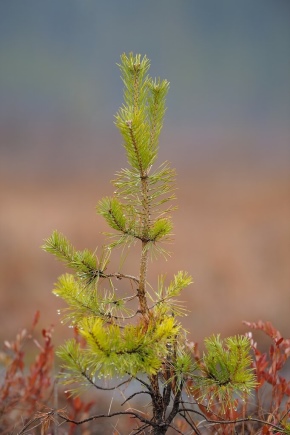
Pine is an evergreen slender beauty. She is able to become a worthy decoration of any land plot, successfully fits into all kinds of creative solutions of landscape designers. Conifers create not only a unique visual accent of the landscape composition, but also strengthen the soil and saturate the surrounding air with phytoncides. These volatile substances have a beneficial effect on the functioning of the central nervous, cardiovascular and respiratory systems. Many owners of large land areas plant not one, but several conifers on their land.
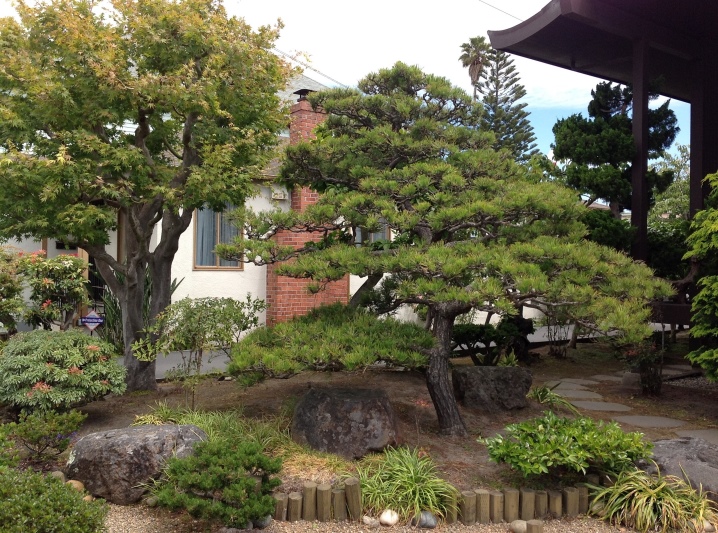
The right time
The best time to plant pine is in the spring season (mid-April - early May). The roots of conifers take root much more difficult than that of seedlings of flowering trees (oak, linden, mountain ash). In spring and summer, during a warm period, a young pine tree will have time to harden itself well and begin to develop successfully. You can transplant a pine tree in early autumn, for the middle lane this is the period from about August 20 to September 20... At this time, stable indicators of humidity and temperature are observed in nature. In such conditions, seedlings are easier to transplant.

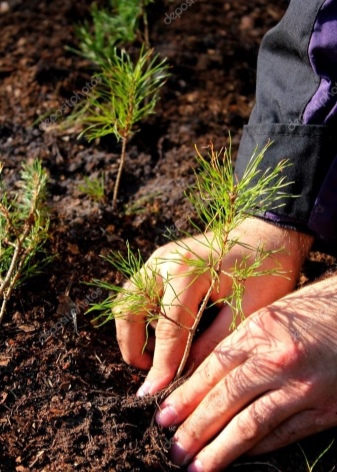
Compliance with the timing of the transplant is an important point. If, for some reason, the optimal dates for spring planting are missed, and in June a suitable pine tree fell in love in the forest, you should not risk it, since the root weakened by transplantation may not cope with the nutrition of the seedling during the period of active growth. It is necessary to leave a mark on the tree and return for it in early autumn on time.
When transplanted in late autumn, the roots will not have time to take root before the onset of stable cold weather, the tree will not be able to successfully overwinter and will die.
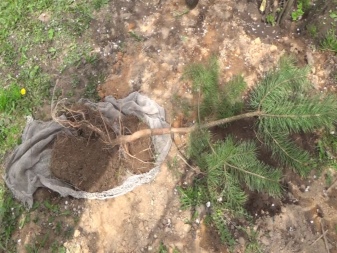

How to choose and dig up a seedling?
The easiest way is to purchase pine planting material of the selected variety in a specialized store, with roots packed in a container. So you can bring the tree home without any problems and plant it in compliance with the recommendations of botanists.
However, it is not always possible to buy seedlings. Many amateur gardeners prefer to transplant conifers from the nearby forest. It is better to choose seedlings for transplanting to your site from the edge of the forest or from the forest edge. It should be borne in mind that the depth of the taproot of the seedling is approximately equal to the height of the plant, and the root system in width is commensurate with the span of the lower branches of the tree.
The age of the seedlings for better survival is 2-3 years, the height is 50-70 cm. Experienced gardeners recommend choosing small plants, since they are easier to dig up and transport from the forest to your site than large ones. But now the choice has been made, the optimal time has come, it's time to go to the forest for a pine tree.
It is important to maintain the orientation of the tree to the cardinal points. Take a compass with you if you find it difficult to determine the cardinal points in the forest without it. Determine by the compass on the tree a branch pointing to the north, leave a mark on it (ribbon, lace, string). When landing at a new location, the marked branch should also be directed to the north (it is easy to check with the compass).

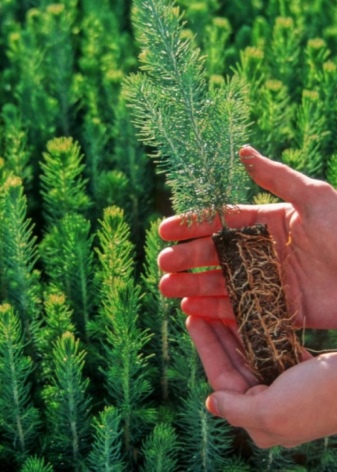
It is necessary to dig out the seedling with a large (about 20 kg) earthen clod so as not to disturb the root system. You will need a bucket, a bayonet shovel, cloth (burlap, canvas), some kind of container (a large basin will do, a strong cardboard box from household appliances).In dry weather, before digging, you need to water the tree with one bucket of water. First, you need to dig in a pine tree in a circle to the width of the lower branches. Then you need to slowly, carefully dig around the perimeter as deep as possible.
Do not forget that pine has a long taproot. Having gone deep enough, you need to find the taproot under the roots with your hand, so as not to accidentally damage it with a shovel. Then the tree with the earth must be slightly raised with a shovel, like a lever, preventing the earthen clod from scattering, bring burlap under the shovel and carefully wrap the clod. Holding the tree by the trunk, carefully remove the seedling together with the soil wrapped in cloth, place the roots in a bag, bandage and place in a prepared container for transportation.
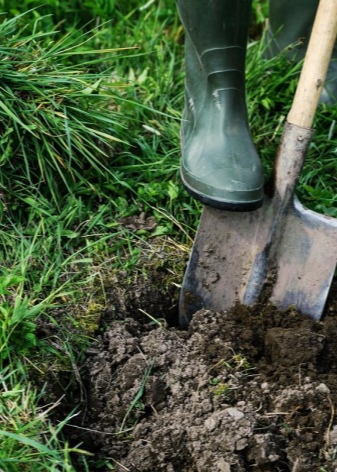
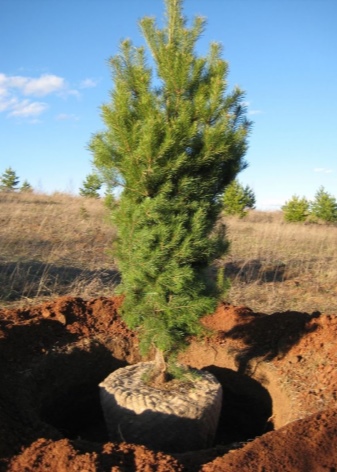
The difficulty of digging is that the roots of the conifers contact with open air is categorically contraindicated, since a special mycorrhiza fungus will die in 10-15 minutes, without which the nutrition of the pine tree is impossible, it will not take root and will die very soon. If it did not work out with an earthen lump, the soil crumbled, and the roots were bare, they must be immediately moistened, wrapped in a wet cloth and not allowed to dry out, constantly moistening during transportation.
Before planting, you can dip the roots into the Kornevin solution, but you must be prepared for the fact that it will be difficult for such a seedling to take root.
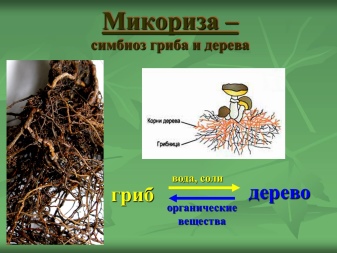
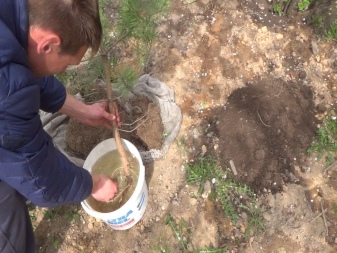
How should you transplant?
In order for the pine to take root well, you need to find a suitable place for it. Pine loves sandy and sandy loam soils with acidity close to neutral (pH value 5.5-6.5), prefers sunny areas. For disembarkation, it is better to take a place on a hillock than in a lowland, without swampiness and high standing groundwater. Heavy clay or saline soils are not suitable for growing pine, and fertile garden soil is not suitable.
In most cases, pines are planted around the perimeter of the plots. If you plan to grow several trees, then the area for them should be sufficient to maintain the distance between them 3.5-4 m for tall varieties and 1.5-2 m for low-growing varieties.
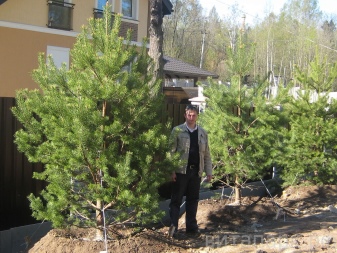
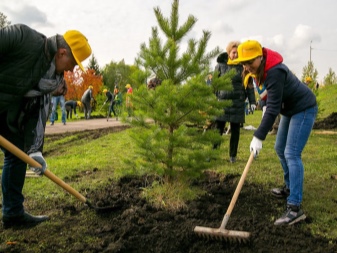
The powerful root system of an adult strong ephedra, located close to the soil surface, is capable of turning out earth layers, destroying garden paths, penetrating the foundation of a house and damaging it, therefore, it is impossible to plant pine in the immediate vicinity of buildings. In addition, there is a possibility of lightning striking a tall pine tree during summer thunderstorms, a resinous tree can catch fire, and the fire can easily spread to housing if the tree grows close. According to fire safety standards, planting tall trees should be at a distance of at least 10 m from buildings.
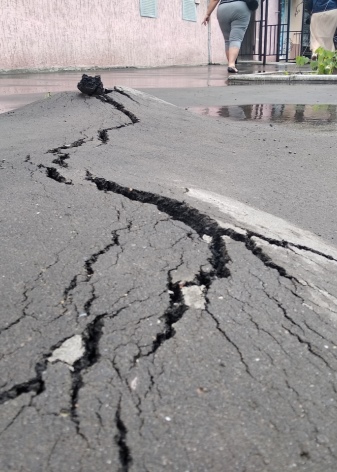
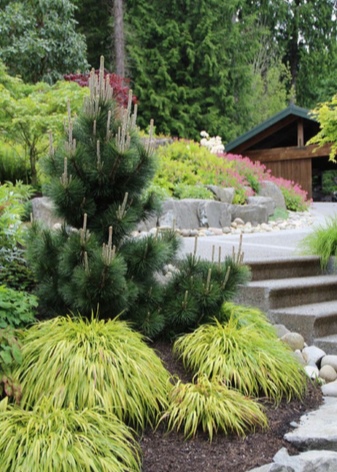
When deciding to plant a pine tree on the site, you need to take into account the moment that in the process of growing the tree will take more and more resources, and when it grows, nothing will grow around it within a radius of 5-6 m. Fruit plantations grow without problems in the vicinity of a pine tree only when planted at an appropriate distance.
Transplanting a young pine tree from the forest to your summer cottage is not as easy as it might seem at first glance. For the procedure to be successful, it is necessary to carry out preparatory work before digging a seedling in accordance with certain rules and recommendations of specialistsso that the little pine tree does not die due to the stress suffered and the mistakes made.
Everything should be thought out in advance: the planting site is correctly selected and prepared, the time for digging out the seedling is determined, proper transportation is ensured, recommendations for subsequent care are studied. This directly affects the result - the survival rate, normal development and decorativeness of the young ephedra. Particular attention should be paid to reducing the length of time from excavation to planting in the ground, this affects the viability of the root system.
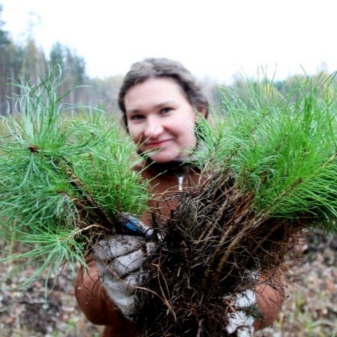
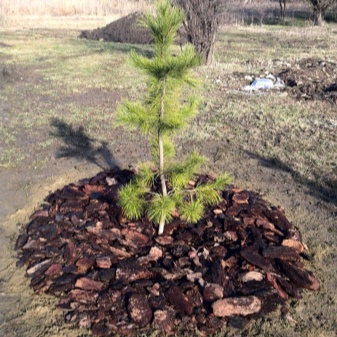
A spacious planting pit should be prepared in advance, its dimensions should exceed the size of the root system by about 1.5-2 times... A drainage layer (about 20 cm) is laid at the bottom, for this you can take fine gravel, expanded clay. Then you can put humus (about 450-500 g). So that the roots do not touch the fertilizer, humus must be covered with a layer of soil (up to 10 cm), after stirring 20-50 g of nitrogen fertilizers in the soil. Then you need to pour half a bucket of water into the pit. When replanting forest pines to another place, it is important to bring the new conditions as close as possible to the old ones.
Professionals recommend filling the planting hole with soil taken from the forest at the place of the tree's former habitat. This will provide the plant with a normal "habitual" diet.
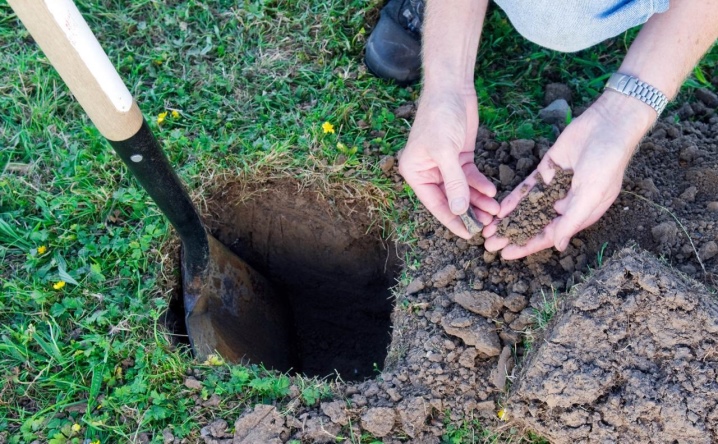
The seedling, together with a clod of earth, is installed in the center of the pit. The tree is positioned taking into account the orientation to the cardinal points in the same way as it grew in the forest. The root collar should be about 2 cm above the ground level. In the future, the soil will plant, and the root collar will approach the soil level.
Forest soil, brought from the place where the pine tree grew, is evenly poured into the pit, compacted the soil around the trunk, watered abundantly with water at room temperature and mulch the trunk circle with natural materials: fallen needles, crushed bark, wood chips, small chips. To avoid burns from the spring sun, the seedlings must be temporarily shaded. To do this, you can adapt a large cap made of burlap, an old cotton or linen sheet, or something else like that. In garden centers, you can find special covering material.
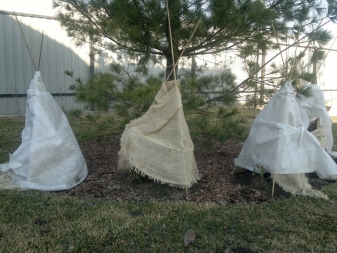
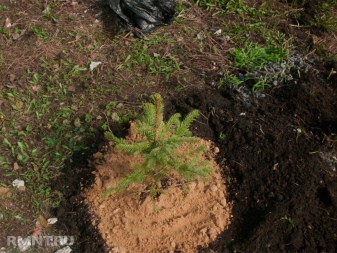
Further care
After transplanting, a young tree needs proper care so that it successfully takes root and grows a worthy decoration of the garden landscape. It is not difficult to take care of the conifers, it is enough to organize the correct watering, feeding and pruning of the plant.
Watering
In order for the seedling to take root well and grow, it must be watered abundantly in the first 2-3 days after transplanting. If it is spring, then further watering is not required, usually the pine has enough moisture from seasonal rains, waterlogging is not allowed. If the summer turned out to be dry, then a young pine tree should be watered as needed under the root and sprinkled over the crown from a watering can. If they were transplanted in late summer - early autumn, then the seedlings are watered once a week so that the root system is better prepared for wintering and does not freeze. About 2 weeks before the onset of stable frosts, watering is stopped.
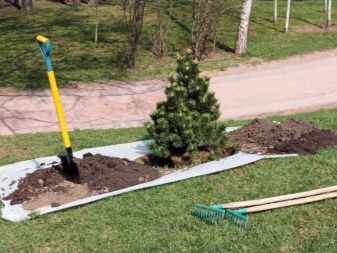
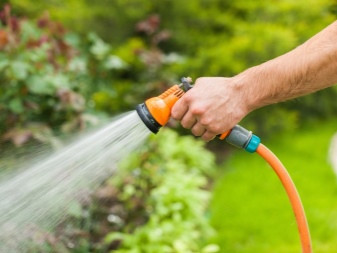
Top dressing
It is not necessary to feed the pines immediately after transplanting, the necessary fertilizers are laid directly into the planting pit. In the future, when young needles begin to grow, you can feed the seedlings with complex mineral fertilizers or special fertilizer for conifers. You need to know that pine cannot be fed with fresh manure, herbal infusions, bird droppings... Over time, under the pine, from the fallen needles, a kind of coniferous litter that does not need to be removedas it serves as a source of nutrients for the tree and keeps the roots of the plant from drying out.

Pruning
For ephedra, special pruning is not required, unless at the request of the owners to form the specified crown parameters. But sanitary pruning is mandatory. You need to constantly monitor the state of the branches. As soon as signs of pathology appear (dry weak branches, bare from needles), they are immediately cut out.
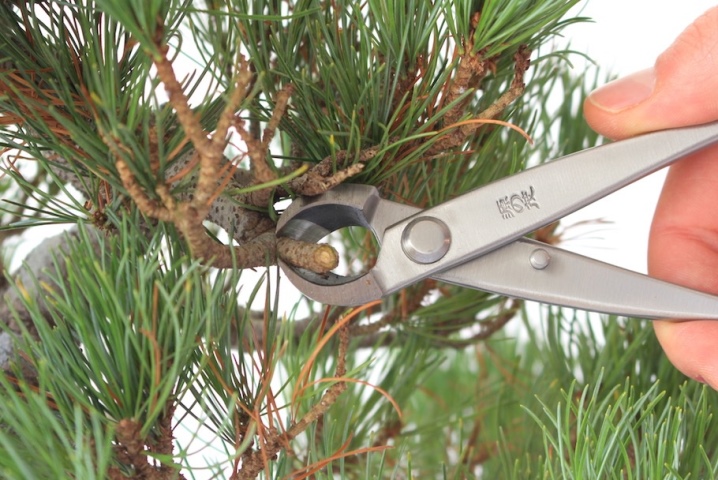
Preparing for winter
For winter, young pines should be covered in the first years to protect them from frost. For this, burlap, spruce branches, a special covering material spunbond are used. Plastic wrap will not work, it does not allow air to pass through and can provoke fungal infections of plants.
Do not rush to clean the shelter in the spring, as it will not only keep it from freezing in winter, but also protect it from sunburn in the spring.After a few years, the grown pines will calmly endure the winter cold.
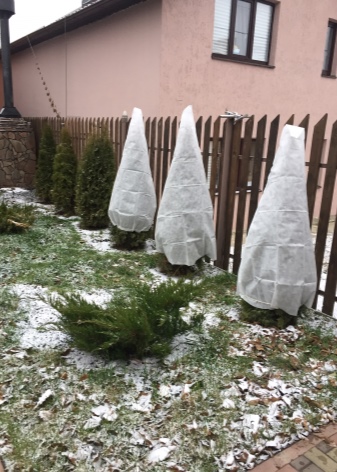
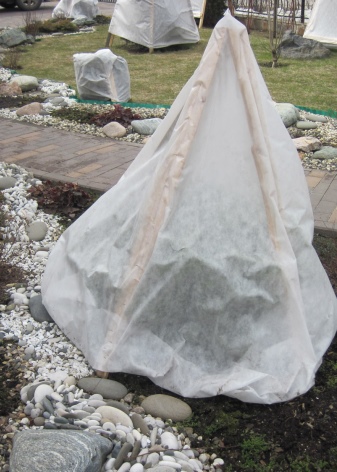
Common mistakes
Incorrect transplantation of a pine sapling from the forest to a house plot or summer cottage will inevitably lead to the fact that the tree does not adapt well to a new place, does not grow, is sick for a long time, or even dries up altogether, seemingly for no apparent reason. Often the owners are lost in conjectures and cannot understand what is the matter. The reason for this condition of the seedling can be gross mistakes made when transplanting an ephedra. The most common ones are:
- improper digging of a seedling, insufficient size of the earthen coma, as a result of which the roots are damaged;
- prolonged exposure of the dug out seedling in the open air with bare roots, which leads to drying out and death;
- improper placement of the tree in the planting hole with the deepening of the root collar;
- wrong choice of landing site;
- non-observance of the optimal timing of transplantation, which significantly reduces the survival rate;
- planting in unsuitable soil.
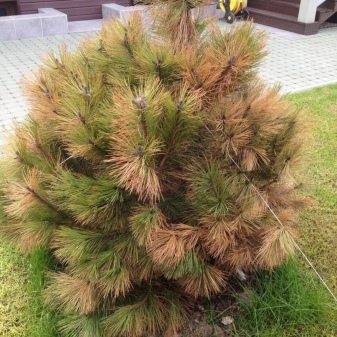
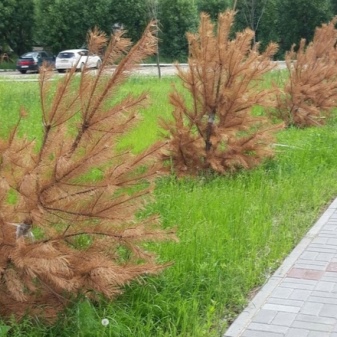
If you prepare well for transplanting an ephedra, take into account all the important points, try not to make mistakes, you can significantly increase the survival rate of seedlings, and then young strong pines, and then adult trees, will delight the owners of the site all year round: in the summer they will fill the surrounding air with a wonderful resinous aroma , and in winter, fluffy green beauties in white snow caps will create picturesque winter landscapes, from which you simply “cannot take your eyes off”.
It should be noted that ancient Slavic beliefs have survived to our times, according to which it is believed that pine, oak and birch have strong energy, and their presence on the site strengthens the house and household members. According to other signs, it is impossible to grow strong forest conifers near the house, they "survive" the owners from the house. Of course, for most of our contemporaries, superstitions and omens are irrelevant, but still there are many suspicious people who continue to believe in something like that. It is better for such people to refrain from planting pines in their plots.
For information on how to plant a pine tree correctly, see the next video.



































































The comment was sent successfully.